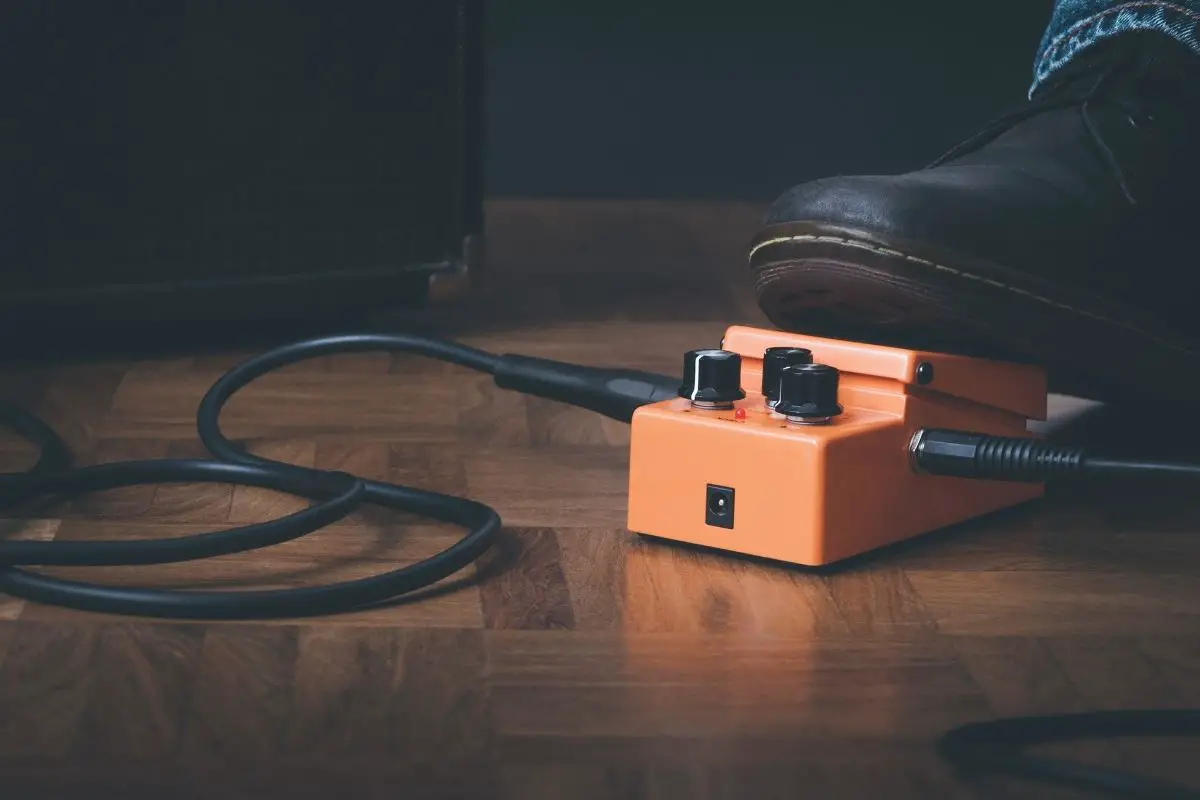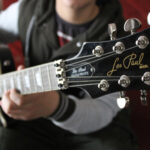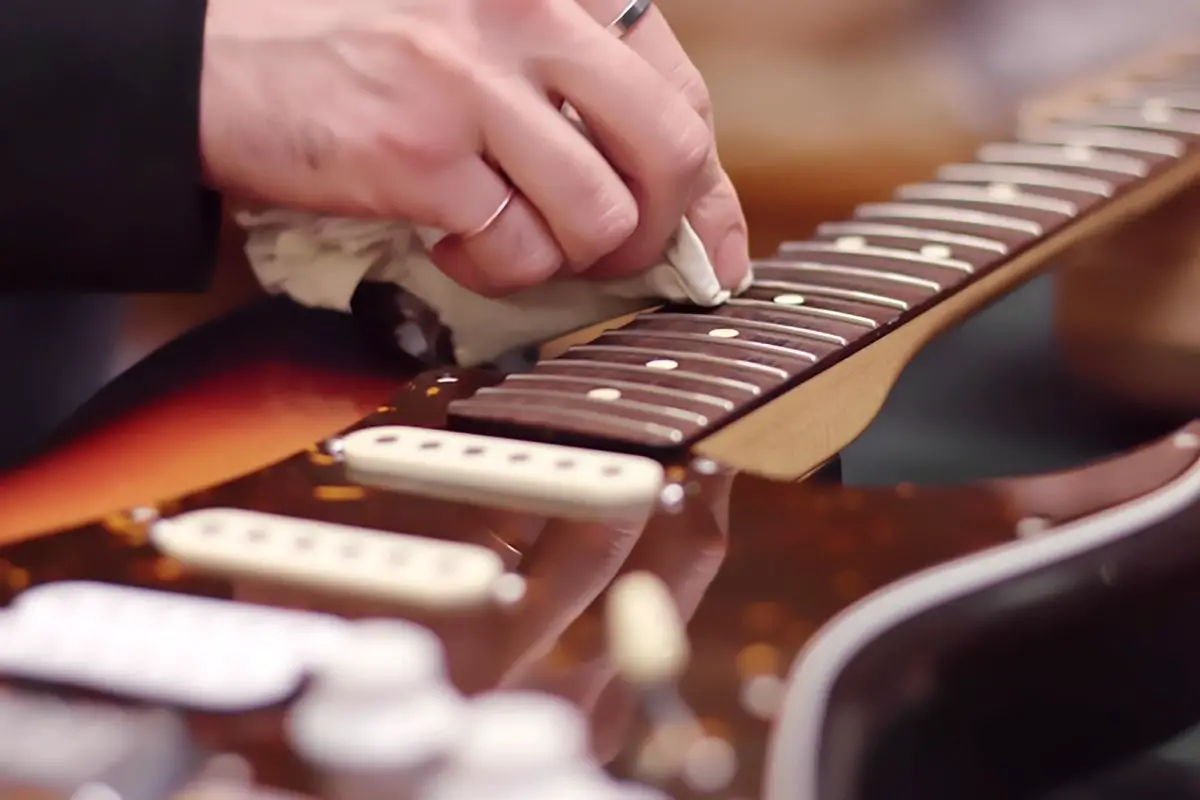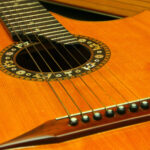Whammy bars, also known as tremolo bars, have been an essential tool for many guitarists looking to add more expression and dynamic range to their playing.
Essentially, a whammy bar is a lever attached to the bridge of a guitar, allowing the player to temporarily alter the pitch of the strings, creating a vibrato or pitch-bending effect. Although whammy bars are most commonly associated with electric guitars, they can also be installed on some other types of guitars.
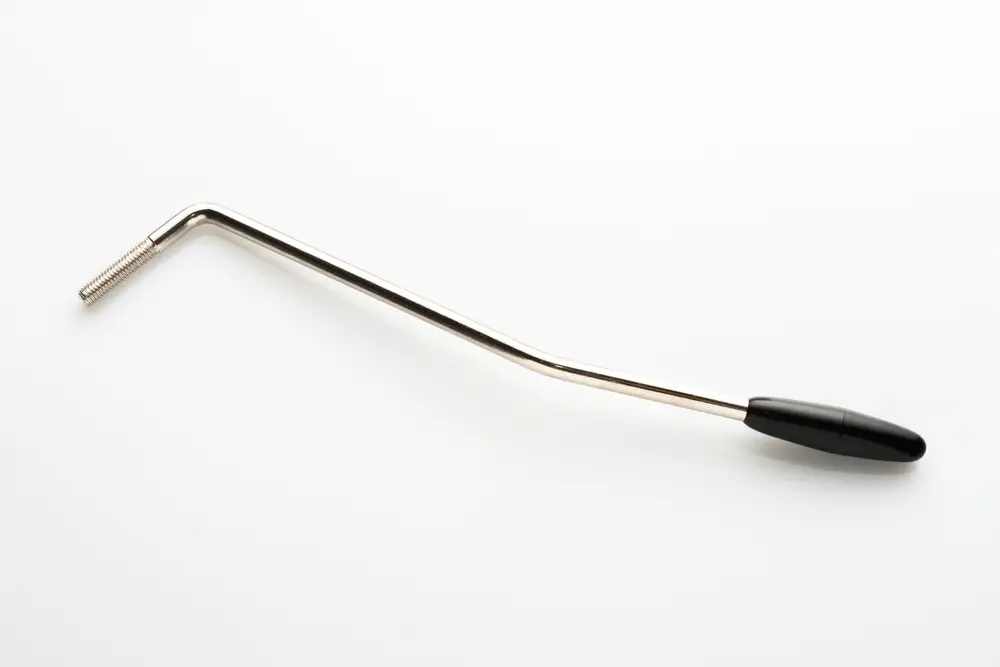
The ability to add a whammy bar to a guitar depends on various factors, including the type of guitar and its bridge design. Some guitar models come with built-in tremolo systems, while others may require modifications or installations to accommodate a whammy bar.
It is essential to understand the compatibility of your guitar with a specific whammy bar system before attempting installation or modification.
Key Takeaways on Can You Put a Whammy Bar on Any Guitar?
- Whammy bars can be added to compatible guitars for expressive pitch-bending effects.
- The installation process depends on the type of guitar and its bridge design.
- Understanding the differences between guitars and whammy bars ensures proper installation and performance.
See these other popular posts on this category:
- Can You Leave a Guitar in a Hot Car?
- Can You Cut Guitar Strings with Scissors?
- Can I Use a Coin as a Guitar Pick?
Understanding Whammy and Tremolo Bars
Whammy bars and tremolo systems can bring versatility to your instrument when playing. Let me share what I’ve learned about these essential components that can add more expression to your music.
Whammy bars, also known as tremolo arms or vibrato bars, are typically found on electric guitars. They attach to the bridge of the guitar and help achieve various sound effects by altering string tension. The tension can be increased or decreased, resulting in pitch modulation. Some popular vibrato systems include the Floyd Rose, Bigsby tailpiece, and synchronized, floating, and locking tremolo systems.
The Floyd Rose is an advanced and precise type of locking tremolo system. It enables users to perform extreme pitch bending while maintaining tuning stability. It’s a favorite among many rock and metal players who love dive-bombs and other outrageous effects.
On the other hand, vibrato systems like the Bigsby tailpiece provide a more subtle effect. The Bigsby is often seen on hollow or semi-hollow body guitars and is perfect for players looking to introduce gentle vibrato with a vintage feel.
One key aspect of whammy bars is the functionality they offer to the bridge. A tremolo bridge provides the platform for the whammy bar to sit on, allowing for smooth operations in pitch modulation.
Common tremolo bridge systems include the synchronized tremolo and floating tremolo systems. The synchronized tremolo is found in most Fender guitars like the Stratocaster, while guitars with a floating tremolo have the ability to raise and lower their pitch.
Furthermore, a locking tremolo is designed to keep your guitar strings in tune even after dramatic pitch modulations. It does this by locking the strings at the nut and the bridge, thereby maintaining the string tension, and ensuring a stable playing experience.
To install a whammy bar, simply screw it into your guitar’s bridge or tremolo system. Connecting a whammy bar involves just a few basic steps, and once securely attached, you can start exploring the new dimension it brings to your playing. But always remember that not every guitar can accommodate a whammy bar, as the specific bridge and guitar design will determine compatibility.
In conclusion, whammy bars and tremolo systems are essential tools for achieving various musical expressions on the guitar. From subtle vibrato to wild pitch bends, these devices empower players to explore their creativity and invent unique sounds.
Keep in mind to consider your preferred playing style and the specific requirements for your guitar when deciding on a whammy bar or tremolo system.
The Applications and Effects Of Whammy Bars
Whammy bars have become an essential part of many rock and metal performances due to their ability to produce unique sounds and tonal possibilities. Whammy bars, or tremolo arms, are attached to electric guitars and allow players to bend the pitch of the strings by applying tension.
There are several types of whammy bars, such as the traditional tremolo system and the more advanced Floyd Rose bridge, each offering a unique range of effects.
If you want to add a vibrato effect to your playing, the whammy bar can be gently pushed or pulled to create slight and controlled pitch variations. This versatile tool can be used to produce smooth pitch bends in solos and even simulate the dive-bombing sound, reminiscent of old aircraft swooping through the air.
Players like Eddie Van Halen have made this technique quite popular in shredding guitar solos.
Whammy bars aren’t just limited to dive-bombing and pitch bends; they are also capable of creating unique sonic textures, such as harmonics and squeals, which give an extra edge to a guitar performance. To achieve these sounds, lightly touch the strings while applying the whammy bar, letting the pitch rise and fall, creating an eerie harmonic effect.
Despite the vast range of tonal possibilities afforded by the whammy bar, it’s essential to keep in mind that aggressive and prolonged use can lead to potential damage to the guitar’s bridge and tuning stability. With proper technique and maintenance, guitarists can minimize any detrimental effects and continue to enjoy the expressive power of the whammy bar.
In conclusion, the whammy bar is an incredible tool for electric guitarists, offering a wide array of tonal possibilities and unique sound effects. By understanding the different types of whammy bars and mastering proper techniques, guitarists can unlock a whole new world of expressive playing.
Installing A Whammy Bar On Your Guitar
There are a few key factors to consider when installing a whammy bar on your guitar. First and foremost, it’s essential to recognize that not all guitars are compatible with the installation of a whammy bar. Most electric guitars can accommodate a whammy bar, but it’s relatively uncommon for acoustic guitars to have this type of hardware.
Installing a whammy bar on an electric guitar is typically a straightforward process. The first step is to find the right type of whammy bar for your guitar’s specific design. This might involve researching and possibly consulting with a guitar technician if you’re unsure.
Once you’ve acquired the appropriate whammy bar, all that’s left to do is secure it in place. For threaded whammy bars, this process involves inserting the bar into the hole provided on your guitar’s vibrato system and screwing it in a clockwise direction until you feel some resistance.
If you’re working with a non-threaded whammy bar, simply push the bar into the designated spot, and the installation is complete.
Although electric guitars are generally suited for whammy bar installations, acoustic guitars are a different story. It’s relatively rare to find an acoustic guitar compatible with a whammy bar due to the specific construction of the instrument, and attempting to install one without proper guidance or hardware modifications can lead to damage.
If you’re determined to add a whammy bar to your acoustic guitar, it’s best to consult with a professional guitar technician about whether it’s feasible and how to approach the installation safely and effectively.
The process of installing a whammy bar on a guitar depends on the type of instrument you’re working with. Electric guitars are generally better-suited for this hardware addition, whereas acoustic guitars may require more extensive modifications or guidance from an experienced tech.
The key is to ensure you have the right type of whammy bar for your guitar and understand how to secure it properly so that you can reap the benefits of this versatile accessory.
Differences Between Various Guitars and Whammy Bars
As a guitarist, I’m often asked about the compatibility of whammy bars with different types of guitars. In this section, I’ll discuss some of the main guitar types and how whammy bars can be used with them.
Starting with electric guitars, we have the popular Fender Stratocaster and Fender Telecaster. Both of these models come with various bridge systems, including those that allow for a tremolo arm or whammy bar.
Stratocasters, in particular, are known for their tremolo systems, making these guitars perfect candidates for whammy bar usage. Telecasters, on the other hand, usually have a fixed bridge, but aftermarket modifications can sometimes be made to accommodate a whammy bar.
The Les Paul is another well-known electric guitar model with a fixed bridge. Although it doesn’t typically come with a whammy bar, you can install aftermarket tremolo systems, requiring some adjustments to the guitar, such as routing the cavity and reinforcing the neck pocket.
Semi-acoustic and acoustic guitars don’t usually come with a tremolo system as it’s not a common feature for these instruments. However, in very rare cases, it’s possible to find a semi-acoustic guitar with a built-in tremolo system. Acoustic guitars, on the other hand, aren’t suitable for whammy bars due to their construction.
Bass guitars normally don’t have whammy bars because they are focused on providing a stable and precise low-end sound, which would be disrupted by the vibrato effect of a whammy bar. However, a few specialized models of bass guitars may include a tremolo system for more experimental players.
Finally, steel guitars and other specialized guitar types generally don’t have whammy bars as their design and playing technique don’t support the use of this accessory.
While not all guitars are compatible with a whammy bar, many popular electric guitar models like the Stratocaster or modified Les Paul can accommodate this accessory. For those interested in experimenting with a whammy bar, it’s essential to consider the construction and bridge system of the guitar to ensure a proper fit and functionality.
The Role of Whammy Bars in Different Music Genres
When thinking of whammy bars, several music genres come to mind. Whammy bars are commonly used in rock, country, metal, and even traditional music styles. The versatility of the whammy bar has opened up new possibilities for guitarists, enabling them to create distinct and unique sounds.
In rock music, the whammy bar plays a significant role in shaping the sound. Guitar legends such as Jimi Hendrix and Eddie Van Halen popularized the use of whammy bars in their playing. They incorporated dive-bombs, squeals, and subtle vibrato effects to create their signature styles.
By manipulating the whammy bar, they were able to achieve unprecedented control over the pitch, leading to innovative and experimental sounds that would become iconic in rock music.
Country music also utilizes the whammy bar, albeit in a more subtle manner. Country guitarists often use the whammy bar to create a smooth, flowing vibrato that enhances the expressiveness and emotion of their playing. By incorporating the whammy bar into their playing style, country guitarists can convey a greater sense of depth and feeling in their music.
Metal is another genre where the whammy bar has made a significant impact. Much like in rock music, metal guitarists push the whammy bar to its limits, using it to create aggressive and dissonant sounds. Dive-bombs, rapid pitch changes, and tremolo picking are common techniques in metal, and the whammy bar is a crucial tool for achieving these extreme effects.
Lastly, traditional music genres have also found unique ways to incorporate the whammy bar. In some cultural music styles, the whammy bar is used to emulate the controlled pitch bends and microtonal variations found in traditional stringed instruments. This allows guitarists to authentically represent the nuances of their culture’s musical heritage while also exploring new sonic possibilities.
Guitarists must appreciate the diverse uses of the whammy bar across various music genres. It’s a creative tool that can inspire and elevate a guitarist’s playing, no matter the musical context.
The Influence and History of Whammy Bars
In the world of electric guitars, whammy bars have played a significant role in shaping the sound and techniques used by countless musicians. Whammy bars, also known as tremolo bars or vibrato bridges, first gained popularity in the rock music scene.
This versatile tool allows guitar players to manipulate the tension of the strings, creating a range of expressive effects from subtle vibrato to dramatic pitch bends.
Paul Bigsby, an innovative luthier, and Floyd D. Rose, another skilled inventor, were key figures in the development of whammy bar systems. Bigsby developed his own tremolo system in the late 1940s, which was then adopted by many musicians due to its smooth design and overall functionality.
Floyd Rose later revolutionized the whammy bar with his double-locking design, allowing guitarists to perform extreme pitch bends and dive bombs without losing tuning stability.
While some people may refer to whammy bars using slang terms like “wiggle stick,” their impact on modern guitar playing is anything but trivial. The integration of the whammy bar in numerous guitar models has opened up new possibilities for both experienced and aspiring musicians. With a simple dive or expressive vibrato, guitarists can effectively convey emotion and channel their creative energy.
Regardless of the specific whammy bar system, the importance and influence of this invention are undeniably significant. It blurred the lines between traditional and experimental styles, allowing musicians to explore the full spectrum of their instrument’s capabilities.
From the early days of rock ‘n’ roll to the current crop of diverse genres, whammy bars have remained an integral part of the guitar player’s toolkit.
Tips for Maintaining Your Whammy Bar
When it comes to using a whammy bar on your guitar, it’s essential to keep it in good condition and minimize tuning issues. Here are some tips I’ve found helpful for maintaining a whammy bar and ensuring top-notch performance.
Firstly, it’s important to make sure the strings are properly stretched and settled before using the whammy bar. I usually play my guitar for a while and gently tug on the strings to help them stretch. This helps prevent tuning issues that can arise from using the whammy bar too aggressively.
Next, pay close attention to the tightness of the whammy bar itself. If it’s too loose, it can affect the guitar’s tuning stability and make it difficult to perform techniques like dive bombs and fast vibrato accurately. To maintain the optimal tightness of the whammy bar, regularly check the screw or collet (depending on the type of bridge) and tighten it as necessary.
Since the whammy bar is attached to the guitar’s bridge, it’s crucial to keep the bridge clean and lubricated. Constantly clean the bridge with a soft cloth to remove any dirt or debris, and occasionally apply a small amount of lubricant, such as graphite or silicone, to the contact points between the bridge and the strings. This helps the bridge move smoothly when using the whammy bar and keeps the tuning stable.
When it comes to tuning issues with the whammy bar, locking tuners can be a major help. Locking tuners hold the strings securely in place, which can significantly improve tuning stability when using the whammy bar. If your guitar doesn’t have locking tuners, you might consider installing them to reduce the potential for tuning problems.
Finally, frequent and aggressive use of the whammy bar can sometimes result in strings breaking. To minimize this risk, I recommend checking your strings for wear and replacing them regularly, especially if you use the whammy bar often.
By following these tips, guitarists can maintain their whammy bar and keep it in optimal condition, ensuring a smooth and enjoyable playing experience on my guitar.
Frequently Asked Questions
What types of guitars can you add a whammy bar to?
You can add a whammy bar to most electric guitars that have a compatible bridge. However, it is not advised to install whammy bars on all types of guitars, especially acoustic ones, as they often lack the necessary structure to support the tension changes caused by a whammy bar.
How do you install a whammy bar on a guitar?
To install a whammy bar on a guitar, first, ensure that the guitar has a hole in the bridge or tremolo system specifically designed for a whammy bar. Once you’ve confirmed that, simply insert the screw-like end of the whammy bar into the hole and tighten it securely.
Can a whammy bar be added to a Telecaster?
Yes, a whammy bar can be added to a Telecaster, though it might require some modifications to the guitar. There are specific aftermarket tremolo systems designed for Telecaster models, which makes it possible to add a whammy bar without affecting the guitar’s overall performance significantly.
Do whammy bars affect guitar tuning?
Whammy bars can affect the tuning of a guitar, especially when used aggressively. The tension changes caused by a whammy bar can lead the strings to go sharp or flat, depending on how much pressure is applied.
Some whammy bar systems, such as the Floyd Rose, are specifically designed to maintain tuning stability even with heavy use.
Are there alternatives to a whammy bar for guitars?
Yes, there are some alternatives to whammy bars for guitars. Some options include using a pitch-shifting effect pedal or a B-Bender, which is a device that can raise the pitch of specific strings. These alternatives may not offer the exact same effect as a whammy bar, but they can provide a similar experience.
What are the differences between various whammy bar systems?
There are a few different types of whammy bar systems, each with its own characteristics. Some common types include the traditional tremolo system, the Bigsby vibrato system, and the Floyd Rose locking tremolo system.
The traditional tremolo system allows for moderate pitch changes while the Bigsby offers more subtle, vibrato-like effects. The Floyd Rose system is known for its tuning stability and is popular among guitarists who use the whammy bar frequently and aggressively.

My name is Howard Matthews and I have been playing the guitar since I was knee-high. My parents like to joke that I was pulling the strings even before I was born. In fact, one of my earliest memories is sitting on the couch with my dad’s guitar, wreaking havoc on the chords.
Now, 40 years later, I can attest that I play them much better than I did back then. I have followed in the footsteps of both my parents – much to their delight – and have been the main guitarist in my band for the best part of three decades.
Music has always been my passion, and until recently my life has been so consumed with it that I haven’t had a moment to have a breath (and I wouldn’t have it any other way)!

